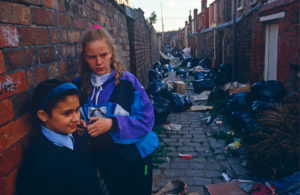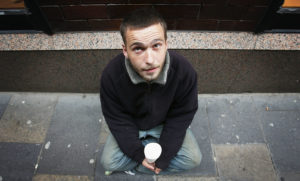Last spring, Elsie, a 77-year-old widow asked ITV’s Good Morning Britain to solicit any advice that Boris Johnson might have about coping with poverty. It was duly explained to the then-Prime Minister that Elsie only ate one meal a day and passed her hours going round and round on the local bus to avoid turning on the heating at home. Squirming, Johnson said that it was only thanks to his decisions that she enjoyed a freedom bus pass — and jaws dropped nationwide.
Elsie’s tragic tale cut through to the public in a way that statistics could not, despite some of the numbers pointing to a resurgence of almost-Victorian aspects of want. Rough sleeping, for example, has shot up by a quarter in a single year. There has been a “significant decrease” in the average age of death in deprived neighbourhoods. The government’s annual poverty figures have just recorded a million more sinking below the breadline and in the same data, released within 24 hours of the fastest food inflation since 1977, officials for the first time ever deemed it important to tally foodbank use.
And yet even the best-intentioned people can simply glaze over at figure-heavy headlines about Britain’s cost-of-living crisis. But if numbers are prone to being ignored, anecdotes can be unrepresentative. To paint a credible portrait of Britain’s new penury, therefore, we need to grapple with statistical tables and personal stories alike — with the quantity and the quality of poverty. I’ve dedicated the last few months to that, working with reporters who are lending an ear to the communities that many politicians would rather ignore.
They have heard tales of bitter hardship that wouldn’t be out of place in a Charles Dickens novel, or in the reporting of George Orwell and J.B. Priestley. In many ways, Britain’s new poverty is much like the old. The street urchins in Dickens’s London and the impoverished mill workers in Engels’s Manchester would be familiar with many of the experiences described by the testimony collated in Broke. The brute privation some describe — the bite of the cold, the gnawing of hunger, the terror of ending up without a roof over their head — would have been shared by many Victorian Londoners. The shock is to find such conditions resurgent in a post-industrial society incomparably richer than that chronicled by Dickens.
Our society may have grown too wealthy to fear mass undernourishment on a 19th-century scale, but our decade could still, like the 1840s and 1930s, earn the unhappy moniker “the hungry” Twenties. A hundred and fifty years after George Eliot likened poverty to leprosy in Middlemarch, on the basis that “it divides us from what we most care for”, a trip to a Tottenham foodbank reveals how poverty can alienate people from those dearest to them. Yvonne, a 63-year-old former social worker with a degenerative spinal condition, still refuses to let her four adult children know that she is struggling, and so cuts herself off from what should be her support network.
Such hardship gets under an individual’s skin and sometimes breaks the spirit. Staff at a GP practice in a run-down part of Glasgow which features in the book affirm how often such thoughts turn into deeds in their part of the world: overdoses and suicides routinely cut grotesquely short the lives lodged in their books.
Despite continuity with the past in the nature of poverty, a lot of the numbers concerning Britain’s current poverty crisis today are decidedly novel. From the Victorian “poor house” through to the Beveridge report, the problem of poverty in the past was — overwhelmingly — a problem of old age. No longer. Pick a pensioner at random and they are markedly less likely to be in poverty than someone plucked from the general population. In her hardship, Elsie has become the exception, not the rule.
The flipside of ameliorating conditions for older Britons has been tanking fortunes for others. The total number of children growing up under the poverty line, which was falling around the turn of the century after Tony Blair and Gordon Brown vowed to eradicate the problem, is rocketing back to its Nineties peaks. The official tally is now just 100,000 short of the 4.3 million record, and once the rear-view-mirror data catches up with the energy crunch, it could scale shameful new heights. The link to specific cuts is getting starker, too. Take the “two-child policy”, a crude attempt to discourage cash-strapped parents from having kids, driven through soon after the Conservatives won single-party power in 2015, which ends up punishing third and fourth children by denying them support. Sure enough, according to Whitehall’s latest numbers, families with three or more children are now twice as likely to have resorted to foodbanks as their smaller counterparts.
Children aren’t the only ones affected. Disabled people, thanks to cross-party reforms from the Seventies, were rarely doomed to destitution. That is, until recently. Following a series of restrictions and freezes, a colleague and I calculated that single disabled people were roughly four times more likely than the non-disabled to be falling behind with their bills, six times more likely to be growing cold, and nine times more likely to be going hungry.
Given the drift of Britain’s demographics, the “new poverty” is inevitably somewhat more diverse than the old — but it is, perhaps, surprising to learn quite how far it skews. A lot of the political discussion, and a lot of very good reporting, has concentrated on England’s “left behind” coastal towns and ageing industrial towns, both of which tend to be white. But if we just concentrate on the hard finances, rather than a vaguer sense of malaise, all of the country’s main ethnic minority groups still suffer from consistently higher poverty rates than the white majority. For some, like British Indians, the gap is these days small; for others — like Bangladeshis and Black Caribbeans — the excess risk of poverty remains double or more. Meanwhile, for a large and growing band of migrants, the “no recourse to public funds” rule frequently spells automatic destitution.
Another break from the past concerns work. There is a particular irony here, given the way the austerity assault on the welfare state was sold as necessary to safeguard the toiling taxpayer. But the rhetorical binaries between “grafters” and “grifters” are ever-less plausible. Over the 2010s, there was a remorseless rise in the relative weight of working poverty: setting pensioners aside, less than half of poor adults lived in a “working household” back in the mid-Nineties; that same proportion steadily rose to 68% by 2019-20.
Can the poverty tide be reversed? We could learn from past success. Pulling the elderly out of poverty did not happen by accident: the change was the result of both successful social policy choices (including controversial means-tested support) and supportive private institutions (notably workplace pensions). There are questions about how sustainable the settlement is, and indeed pensioner poverty is just starting to creep back up. It’s also true that special political factors — a large and growing electorate of pensioners who reliably turn out to vote — helped unlock higher public spending in this field after the Turner Commission reported in 2005.
But these caveats should not distract us from remains an almighty, historic triumph. We should pore over the progress on pensioner poverty, and figure out how to replicate it. Many activists exhibit a weakness: the “despondency problem” sharply defined by the Princeton sociologist Matthew Desmond as being “fluent in the language of grievance and bumbling in the language of repair”. To shrug off the ancient belief that poverty is inevitable, and build faith in change, we must shout about success where we can point to it.
At the same time, the average voter needs to care about poverty. This isn’t always a given. The uncomfortable truth, as Desmond heavily underlines, is that it flows from a system which in some respects serves the majority’s self-interests: the flipside of gnawing insecurity for gig economy workers is, for example, convenience for the consumers.
But one feature of 21st-century hardship may help the cause: namely, a disturbing sense of the boundary between the supporters and the supplicants of life getting blurred as the big squeeze goes up the income ladder.
UnHerd’s own polling underlines this point, with 62% of Brits now agreeing with the statement: “I worry about affording the necessities, such as food and energy.” When those findings are projected across the political map, every constituency across the land registers at least a modest majority in this position. This is the backdrop to the stories of two women we uncovered in Manchester: Phoebe, an increasingly indebted debt advice worker, who admits she’s too scared to commit her own finances to paper; and Sophie, a foodbank volunteer, who one day found she had no choice but to become a foodbank user.
Such tales are palpably disturbing. But they could also provide a chance to reset the debate. The missing ingredient in Britain’s conversation about poverty has been empathy — the poor are talked of as a different species, away on Benefits Street. As ever-more voters feel the pinch, the mood could change. Newly exposed, the majority might be persuaded to repair the holes that austerity has cut in the safety net. Then perhaps we might make progress towards fixing what is currently broke.
Disclaimer
Some of the posts we share are controversial and we do not necessarily agree with them in the whole extend. Sometimes we agree with the content or part of it but we do not agree with the narration or language. Nevertheless we find them somehow interesting, valuable and/or informative or we share them, because we strongly believe in freedom of speech, free press and journalism. We strongly encourage you to have a critical approach to all the content, do your own research and analysis to build your own opinion.
We would be glad to have your feedback.
Source: UnHerd Read the original article here: https://unherd.com/





